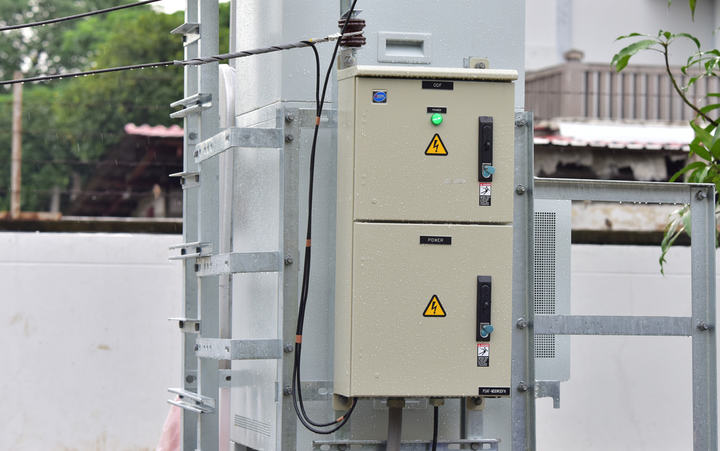The transformer is the most important part of your outdoor lighting setup.
It’s the device that regulates the power to the whole lighting system, controls when they switch on and off, and generally makes your entire system safe.
What makes it super-important that you put your transformer in the right place.
If you don’t protect the device that protects the rest of your lighting, you’re putting the whole system at risk.
Most landscape lighting transformers are waterproof and can be installed outside. If you have a covered space close to your garden, such as a garage or tool shed, this will be a safer location. The transformer should be as close to the lights as possible, though, to minimize voltage drop.
To explore this more, let’s look at:
- Whether transformers can be installed outside
- The best place to install the transformer
- Whether they need to be in reach of your WiFi network
Can Landscape Lighting Transformers Be Installed Outside?

You might assume that being a pretty complex piece of electrical equipment, a transformer should always be placed indoors to protect it from the elements.
However, most of them are designed to be waterproof and weatherproof and so are perfectly fine to be installed outdoors.
Some come with a photocell sensor that allows you to program the lights to turn on when the sun sets.
You could run the photocell away from the transformer, but it’s easier if the whole thing is outdoors already.
Transformers generally have their connections on the underside so that any open areas are pointed downwards, shielded by the body of the transformer.
This means that rain won’t be able to get inside the transformer due to the direction it falls.
Where Should I Install The Transformer?

While transformers are generally waterproof, it’s up to you where you choose to install it. If you can place it in an indoor covered area, you’re only offering more protection.
The transformer should be as close to the lights as possible to minimize voltage drop.
If you place the transformer too far from the lights, then you run the risk of the voltage dropping to a level.
This means the lights are dimmed or flickering, particularly if you’ve wired your circuit in series.
You also need to have the transformer within reach of a GFCI outlet. These have a ground fault circuit interrupter built-in and will cut the power in the event of a ground fault, protecting your home from risk.
If you don’t have one, you’ll need to get one installed. Don’t plug a transformer into a non-protected outlet.
If you’re using an outdoor outlet, you’ll need to buy a special cover (Amazon) for it once the transformer is plugged in, since it’s not a device you’ll be plugging in only when the weather is good.
Some outdoor outlets may have these already, but most don’t.
They’re designed to only be used for lawn mowers or other devices that you unplug once done and aren’t used in bad weather.
The height of the transformer is another important consideration. You should be placing it at least 12 inches from the ground to avoid water damage from splashes.
While it may be tempting to place it higher, to keep it well away from the ground, remember that you need to run a cable from it.
The longer the cable, the more the chance of voltage drop.
It’s also not usually the prettiest metal box, so the closer to the ground it is, the less unsightly too.
The final thing to consider is just how you’ll mount the transformer.
Most have their own mounting built-in, often in the form of hooks that can screw into the wall.
If you’re installing outside onto the side of your home, you’ll either need a masonry drill or a wooden stake that you can fix the transformer to.
If you choose a wooden stake, it must be properly set in the ground – a transformer that ends up toppling over into wet ground is a recipe for disaster.
Also read: Do Outdoor Lights Require Junction Box?
Does A Landscape Lighting Transformer Need To Be In WiFi Reach?

One last thing to consider is whether you’re buying a transformer that has WiFi connectivity (Amazon) built-in.
These are great because they let you control your lights from your phone – no need to manually set any timers at the transformer.
Of course, the trade-off is that they have to be within range of your WiFi router to work.
You’ll need to bear this in mind when choosing where your transformer will be placed.
You can test this in advance using your smartphone by making sure you’re connected to the WiFi and standing where you want the transformer to live.
Check it a couple of times to get a mix of readings since the signal can sometimes vary.
If the WiFi signal isn’t showing at maximum strength, then it may not work reliably, which will only frustrate you.
You can’t move the transformer once it’s installed without a lot of effort re-running cables.
You’ll either need to reconsider where you’re placing the transformer initially or consider buying a signal booster.
These relatively inexpensive devices can just plug into an outlet in your home that’s closer to your garden, acting as a relay.
Make sure you get one that has a range to cover the transformer and where you want to sit outdoors.
You’ll have no problems controlling the lights while relaxing on your patio.
Related: What Size Transformer Do I Need?
Final Words
Transformers are really clever bits of kit, so you must look after them.
However, since they’re usually designed to be waterproof (check when you buy), they’re generally fine to be installed outdoors, which makes it easier to run a cable from them to your lights.
You still need to take precautions, though.
Always install them at least a foot from the ground, make sure they’re secure and can’t fall, and only plug them into protected, waterproof-covered outlets.
Any other tips or thoughts on where to place a transformer?

